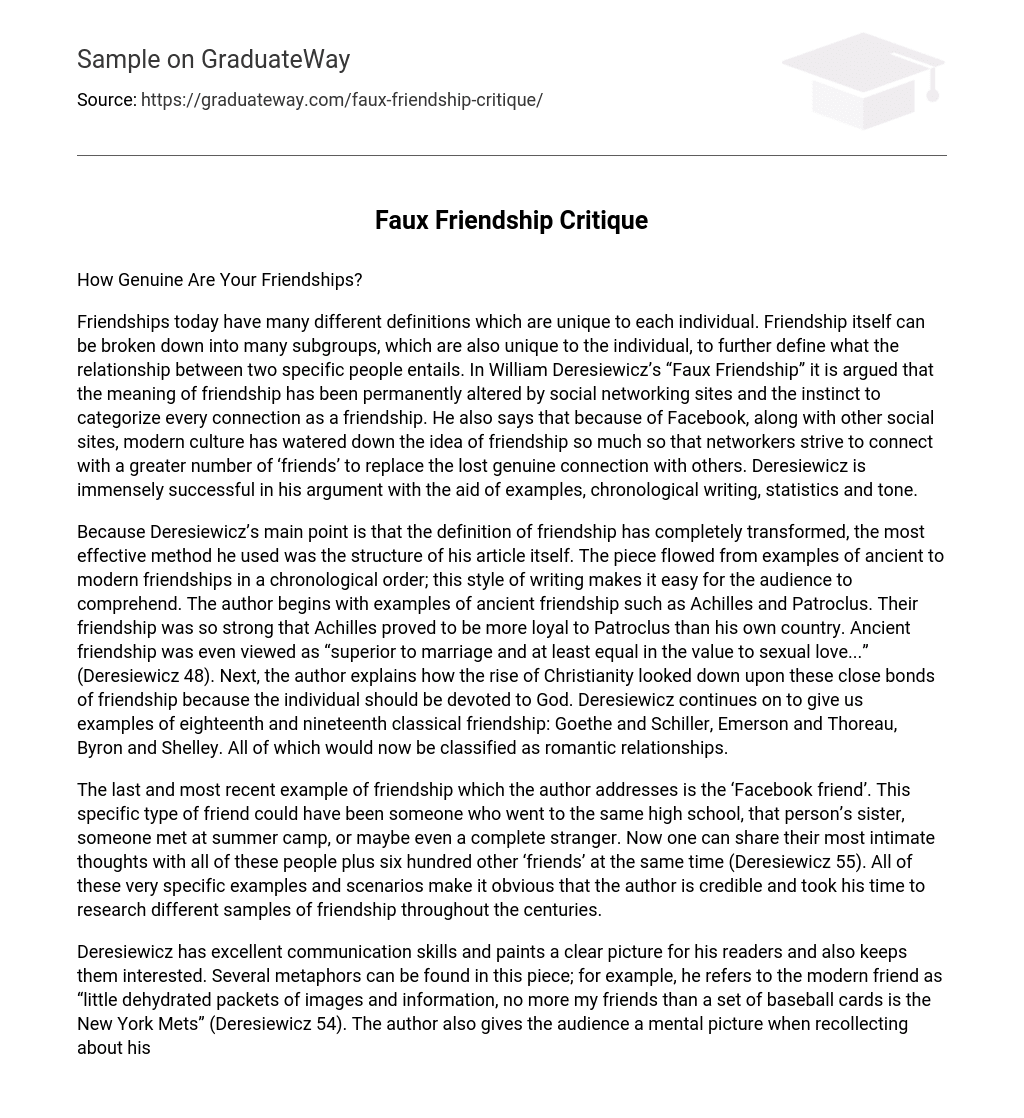How Genuine Are Your Friendships?
Friendships today have many different definitions which are unique to each individual. Friendship itself can be broken down into many subgroups, which are also unique to the individual, to further define what the relationship between two specific people entails. In William Deresiewicz’s “Faux Friendship” it is argued that the meaning of friendship has been permanently altered by social networking sites and the instinct to categorize every connection as a friendship. He also says that because of Facebook, along with other social sites, modern culture has watered down the idea of friendship so much so that networkers strive to connect with a greater number of ‘friends’ to replace the lost genuine connection with others. Deresiewicz is immensely successful in his argument with the aid of examples, chronological writing, statistics and tone.
Because Deresiewicz’s main point is that the definition of friendship has completely transformed, the most effective method he used was the structure of his article itself. The piece flowed from examples of ancient to modern friendships in a chronological order; this style of writing makes it easy for the audience to comprehend. The author begins with examples of ancient friendship such as Achilles and Patroclus. Their friendship was so strong that Achilles proved to be more loyal to Patroclus than his own country. Ancient friendship was even viewed as “superior to marriage and at least equal in the value to sexual love…” (Deresiewicz 48). Next, the author explains how the rise of Christianity looked down upon these close bonds of friendship because the individual should be devoted to God. Deresiewicz continues on to give us examples of eighteenth and nineteenth classical friendship: Goethe and Schiller, Emerson and Thoreau, Byron and Shelley. All of which would now be classified as romantic relationships.
The last and most recent example of friendship which the author addresses is the ‘Facebook friend’. This specific type of friend could have been someone who went to the same high school, that person’s sister, someone met at summer camp, or maybe even a complete stranger. Now one can share their most intimate thoughts with all of these people plus six hundred other ‘friends’ at the same time (Deresiewicz 55). All of these very specific examples and scenarios make it obvious that the author is credible and took his time to research different samples of friendship throughout the centuries.
Deresiewicz has excellent communication skills and paints a clear picture for his readers and also keeps them interested. Several metaphors can be found in this piece; for example, he refers to the modern friend as “little dehydrated packets of images and information, no more my friends than a set of baseball cards is the New York Mets” (Deresiewicz 54). The author also gives the audience a mental picture when recollecting about his circle of close friends and how he realized that most of them did not actually know one another. He then claims that he “…violated the laws of feeling as well as geometry. They (his friends) were a set of points, and I was wandering somewhere among them” (Deresiewicz 54). Deresiewicz uses one of the most concrete pieces of evidence that an author can use– statistics. He claims, “A study found that one American in four reported having no close confidants, up from one in 10 in 1985.
The figures date from 2004…” (Deresiewicz 56). Deresiewicz also uses a very laid back, yet informative tone towards his readers. This approach to writing makes the author seem knowledgeable without coming across as biased. Another advantage to Deresiewicz’s writing style is that he does not come off as an extremist. This works in his favor because readers are more likely to actually consider the author’s opinion plausible. Together, his clever style of writing, use of statistics and tone establish creativity and validity.
Although the author has a substantial argument and evidence, there could be a misinterpretation meaning. Just because Facebook gave the name “friends” to users who can see someone’s profile and information, does not necessarily mean that the users see one another as true friends. The author could have done a little bit of research to find out what this generation of teenagers considers most of their Facebook friends to be in relation to them. With some surveys sent out, he could have very well found out that the modern friend is something that social networking defined, not the new generation.
Overall, Deresiewicz claimed that the definition of friendship has changed over time and he extensively proved his point. Statistical information collected from a study was an excellent addition to his argument; and with his quotes and specific examples of friends and their relationships throughout history, Deresiewicz gave an excellent argument for his readers to ponder over.
Works Cited
Deresiewicz, William. “Faux Friendship.” (E-Dentity). Ed. Stephanie Vie. Southlake, TX: Fountainhead Press, 2011. 47-58. Print.





